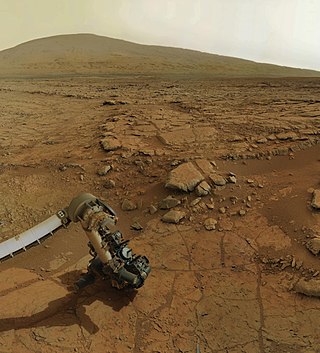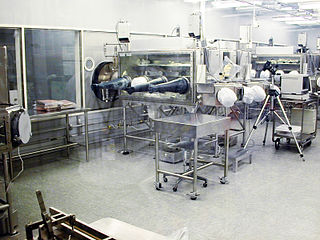Related Research Articles

Astrobiology is a scientific field within the life and environmental sciences that studies the origins, early evolution, distribution, and future of life in the universe by investigating its deterministic conditions and contingent events. As a discipline, astrobiology is founded on the premise that life may exist beyond Earth.

The Drake equation is a probabilistic argument used to estimate the number of active, communicative extraterrestrial civilizations in the Milky Way Galaxy.

Extraterrestrial life or alien life is life which does not originate from Earth. No extraterrestrial life has yet been conclusively detected. Such life might range from simple forms such as prokaryotes to intelligent beings, possibly bringing forth civilizations that might be far more advanced than humanity. The Drake equation speculates about the existence of sapient life elsewhere in the universe. The science of extraterrestrial life is known as astrobiology.
The Fermi paradox is the discrepancy between the lack of conclusive evidence of advanced extraterrestrial life and the apparently high likelihood of its existence. As a 2015 article put it, "If life is so easy, someone from somewhere must have come calling by now."

The possibility of life on Mars is a subject of interest in astrobiology due to the planet's proximity and similarities to Earth. To date, no proof of past or present life has been found on Mars. Cumulative evidence suggests that during the ancient Noachian time period, the surface environment of Mars had liquid water and may have been habitable for microorganisms, but habitable conditions do not necessarily indicate life.
The NASA Astrobiology Institute (NAI) was established in 1998 by the National Aeronautics and Space Administration (NASA) "to develop the field of astrobiology and provide a scientific framework for flight missions." In December 2019 the institute's activities were suspended.

Planetary habitability is the measure of a planet's or a natural satellite's potential to develop and maintain environments hospitable to life. Life may be generated directly on a planet or satellite endogenously or be transferred to it from another body, through a hypothetical process known as panspermia. Environments do not need to contain life to be considered habitable nor are accepted habitable zones (HZ) the only areas in which life might arise.
A shadow biosphere is a hypothetical microbial biosphere of Earth that would use radically different biochemical and molecular processes from that of currently known life. Although life on Earth is relatively well studied, if a shadow biosphere exists it may still remain unnoticed, because the exploration of the microbial world targets primarily the biochemistry of the macro-organisms.

Gerald A. Soffen was a NASA scientist and educator who served in a wide variety of roles for the space agency, primarily dealing with either education or with life sciences—especially the search for life on Mars.

The habitability of natural satellites describes the study of a moon's potential to provide habitats for life, though is not an indicator that it harbors it. Natural satellites are expected to outnumber planets by a large margin and the study is therefore important to astrobiology and the search for extraterrestrial life. There are, nevertheless, significant environmental variables specific to moons.

Extraterrestrial material refers to natural objects now on Earth that originated in outer space. Such materials include cosmic dust and meteorites, as well as samples brought to Earth by sample return missions from the Moon, asteroids and comets, as well as solar wind particles.
Charles Cockell is a British astrobiologist who is professor of astrobiology in the School of Physics and Astronomy at the University of Edinburgh and co-director of the UK Centre for Astrobiology.

Steven J. Dick is an American astronomer, author, and historian of science most noted for his work in the field of astrobiology. Dick served as the chief historian for the National Aeronautics and Space Administration from 2003 to 2009 and as the Baruch S. Blumberg NASA/Library of Congress Chair in Astrobiology from 2013 to 2014. Before that, he was an astronomer and historian of science at the United States Naval Observatory in Washington, DC, from 1979 to 2003.

Lynn Justine Rothschild is an evolutionary biologist and astrobiologist at NASA's Ames Research Center, and was a consulting Professor at Stanford University, where she taught Astrobiology and Space Exploration. She is an adjunct professor at Brown University. At Ames, her research has focused on how life, particularly microbes, has evolved in the context of the physical environment, both on Earth and potentially beyond our planet's boundaries. Since 2007 she has studied the effect of UV radiation on DNA synthesis, carbon metabolism and mutation/DNA repair in the Rift Valley of Kenya and the Bolivian Andes, and also in high altitude experiments atop Mount Everest, in balloon payloads with BioLaunch. Currently she is the principal investigator of a synthetic biology payload on an upcoming satellite mission.
Interplanetary contamination refers to biological contamination of a planetary body by a space probe or spacecraft, either deliberate or unintentional.

Kepler-62f is a super-Earth exoplanet orbiting within the habitable zone of the star Kepler-62, the outermost of five such planets discovered around the star by NASA's Kepler spacecraft. It is located about 980 light-years from Earth in the constellation of Lyra.

The Nexus for Exoplanet System Science (NExSS) initiative is a National Aeronautics and Space Administration (NASA) virtual institute designed to foster interdisciplinary collaboration in the search for life on exoplanets. Led by the Ames Research Center, the NASA Exoplanet Science Institute, and the Goddard Institute for Space Studies, NExSS will help organize the search for life on exoplanets from participating research teams and acquire new knowledge about exoplanets and extrasolar planetary systems.

The Tanpopo mission is an orbital astrobiology experiment investigating the potential interplanetary transfer of life, organic compounds, and possible terrestrial particles in the low Earth orbit. The purpose is to assess the panspermia hypothesis and the possibility of natural interplanetary transport of microbial life as well as prebiotic organic compounds.
The Carl Sagan Institute: Pale Blue Dot and Beyond was founded in 2014 at Cornell University in Ithaca, New York to further the search for habitable planets and moons in and outside the Solar System. It is focused on the characterization of exoplanets and the instruments to search for signs of life in the universe. The founder and current director of the institute is astronomer Lisa Kaltenegger.

The curation of extraterrestrial samples (astromaterials) obtained by sample-return missions take place at facilities specially designed to preserve both the sample integrity and protect the Earth. Astromaterials are classified as either non-restricted or restricted, depending on the nature of the Solar System body. Non-restricted samples include the Moon, asteroids, comets, solar particles and space dust. Restricted bodies include planets or moons suspected to have either past or present habitable environments to microscopic life, and therefore must be treated as extremely biohazardous.
References
- ↑ (Astrobiology) Department of Physics and Astronomy, Washburn University http://www.washburn.edu/faculty/bthomas/WashburnAstrobiophysics.html
- ↑ KU Astrobiophysics, Kansas University Archived 2018-09-27 at the Wayback Machine Accessed 09-05-2019